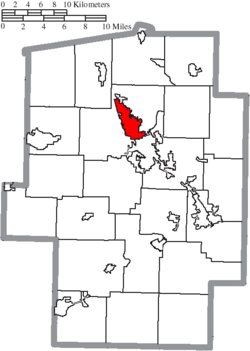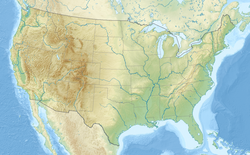Dover is a city in Tuscarawas County, Ohio, United States, along the Tuscarawas River. The population was 13,112 at the 2020 census. It is a principal city of the New Philadelphia–Dover micropolitan area, approximately 68 miles (109 km) south of Cleveland and borders the city of New Philadelphia.
Dover, Ohio | |
|---|---|
 West Third Street in downtown Dover in 2006 | |
 Location of Dover in Tuscarawas County | |
| Coordinates: 40°31′36″N 81°28′40″W / 40.52667°N 81.47778°W | |
| Country | United States |
| State | Ohio |
| County | Tuscarawas |
| Government | |
| • Mayor | Shane Gunnoe |
| Area | |
• Total | 5.90 sq mi (15.28 km2) |
| • Land | 5.79 sq mi (15.01 km2) |
| • Water | 0.10 sq mi (0.27 km2) |
| Elevation | 909 ft (277 m) |
| Population (2020) | |
• Total | 13,112 |
• Estimate (2023)[3] | 12,985 |
| • Density | 2,263.03/sq mi (873.75/km2) |
| Time zone | UTC-5 (Eastern (EST)) |
| • Summer (DST) | UTC-4 (EDT) |
| ZIP code | 44622 |
| Area code | 330 |
| FIPS code | 39-22456[4] |
| GNIS feature ID | 2394554[2] |
| Website | http://www.doverohio.com/ |
History
editOriginally named Canal Dover due to its location and origins along the Ohio and Erie Canal, the land was platted in 1807, with Christian Deardorff and Jesse Slingluff recognized as the founders.[5] Beginning in 1815, the post office first began operation.[6] Canal Dover incorporated as a village in 1842 and became a city under the Ohio municipal code of 1903.[7] On February 12, 1916, the city officially changed its name to Dover.[8]
Geography
editDover is located along the Tuscarawas River, near the mouth of Sugar Creek.[9]
According to the United States Census Bureau, the city has a total area of 5.79 square miles (15.00 km2), of which 5.69 square miles (14.74 km2) is land and 0.10 square miles (0.26 km2) is water.[10]
Demographics
edit| Census | Pop. | Note | %± |
|---|---|---|---|
| 1840 | 598 | — | |
| 1860 | 1,343 | — | |
| 1870 | 1,593 | 18.6% | |
| 1880 | 2,208 | 38.6% | |
| 1890 | 3,470 | 57.2% | |
| 1900 | 5,422 | 56.3% | |
| 1910 | 6,621 | 22.1% | |
| 1920 | 8,101 | 22.4% | |
| 1930 | 9,716 | 19.9% | |
| 1940 | 9,691 | −0.3% | |
| 1950 | 9,852 | 1.7% | |
| 1960 | 11,300 | 14.7% | |
| 1970 | 11,516 | 1.9% | |
| 1980 | 11,500 | −0.1% | |
| 1990 | 11,329 | −1.5% | |
| 2000 | 12,210 | 7.8% | |
| 2010 | 12,826 | 5.0% | |
| 2020 | 13,112 | 2.2% | |
| 2023 (est.) | 12,985 | [3] | −1.0% |
| Sources:[4][11][12][13] | |||
2010 census
editAs of the census[14] of 2010, there were 12,826 people, 5,181 households, and 3,297 families living in the city. The population density was 2,254.1 inhabitants per square mile (870.3/km2). There were 5,578 housing units at an average density of 980.3 per square mile (378.5/km2). The racial makeup of the city was 94.1% White, 1.1% African American, 0.6% Native American, 0.5% Asian, 0.7% Pacific Islander, 1.7% from other races, and 1.4% from two or more races. Hispanic or Latino of any race were 4.1% of the population.
There were 5,181 households, of which 28.5% had children under the age of 18 living with them, 49.7% were married couples living together, 9.8% had a female householder with no husband present, 4.1% had a male householder with no wife present, and 36.4% were non-families. 31.6% of all households were made up of individuals, and 15.6% had someone living alone who was 65 years of age or older. The average household size was 2.37 and the average family size was 2.96.
The median age in the city was 42.9 years. 22.3% of residents were under the age of 18; 7.3% were between the ages of 18 and 24; 22.9% were from 25 to 44; 25.6% were from 45 to 64; and 22% were 65 years of age or older. The gender makeup of the city was 47.4% male and 52.6% female.
2000 census
editAs of the census[4] of 2000, there were 12,210 people, 4,996 households, and 3,362 families living in the city. The population density was 2,319.6 inhabitants per square mile (895.6/km2). There were 5,233 housing units at an average density of 994.2 per square mile (383.9/km2). The racial makeup of the city was 97.09% White, 1.27% African American, 0.25% Native American, 0.51% Asian, 0.02% Pacific Islander, 0.20% from other races, and 0.66% from two or more races. Hispanic or Latino of any race were 0.60% of the population.
There were 4,996 households, out of which 30.2% had children under the age of 18 living with them, 54.4% were married couples living together, 10.0% had a female householder with no husband present, and 32.7% were non-families. 28.8% of all households were made up of individuals, and 14.9% had someone living alone who was 65 years of age or older. The average household size was 2.39 and the average family size was 2.94.
In the city, the population was spread out, with 24.1% under the age of 18, 6.7% from 18 to 24, 26.8% from 25 to 44, 22.5% from 45 to 64, and 19.9% who were 65 years of age or older. The median age was 40 years. For every 100 females, there were 86.9 males. For every 100 females age 18 and over, there were 83.1 males.
The median income for a household in the city was $36,665, and the median income for a family was $44,604. Males had a median income of $34,579 versus $22,397 for females. The per capita income for the city was $18,928. About 7.5% of families and 9.2% of the population were below the poverty line, including 11.1% of those under age 18 and 9.7% of those age 65 or over.
Arts and culture
editDover is adjacent to New Philadelphia, the county seat of Tuscarawas County, with the two cities considered twin cities. Each year, the "Crimson Tornadoes" of Dover High School play the rival "Quakers" of New Philadelphia in a football game that has been played annually for more than a century, and is the fourth longest-running football rivalry in the state of Ohio.[15][16]
Education
editChildren in Dover are served by the public Dover City School District.[17] The current schools serving the city are:
- South Elementary School – grades PK-1
- East Elementary School – grades 2-3
- Dover Avenue Elementary School – grades 4-5
- Dover Middle School – grades 6-8
- Dover High School – grades 9-12
Notable people
edit- Hunter Armstrong, Olympic swimmer, Men's 4 × 100 Gold medal winner at Tokyo 2020
- Elwyn Berlekamp, mathematician
- James R. Black, actor and former National Football League player for the Cleveland Browns
- Frank Ellwood, former head football coach of Marshall University and Georgia Southern University
- Percival "Perci" Garner, III, Major League Baseball player for the Cleveland Indians (2016)[18]
- Vic Gilliam, member of the Oregon House of Representatives and actor
- Ernie Godfrey, college football coach and College Football Hall of Fame inductee
- Theophil Hildebrandt, mathematician
- Joseph C. Hisrich, educator and member of the Wisconsin State Assembly[19]
- Monty Hunter, former National Football League player for the Dallas Cowboys and St. Louis Cardinals
- Frank "Doc" Kelker, college football All-American
- Al Landis, member of the Ohio House of Representatives
- Al Mays, 19th-century Major League Baseball pitcher
- Ray Mears, college basketball coach at the University of Tennessee
- Elliott Nugent, playwright, producer, and actor
- Chris Penso, Major League Soccer referee
- Bob Peterson, animator, screenwriter, and director at Pixar
- William Quantrill, guerrilla fighter, American Civil War
- Trevor J. Rees, former Kent State Golden Flashes head football coach and athletic director
- Allan Sayre, former member of the Ohio House of Representatives
- Mark Dean Schwab, child rapist and murderer
- Zack Space, former member of the United States House of Representatives
- Herald F. Stout, admiral in the United States Navy during World War II and namesake of the USS Stout.
- Al Veigel, former Major League Baseball player for the Boston Bees during the 1939 season
- Stan White, former National Football League player for the Baltimore Colts and Detroit Lions.
- Jeremiah Williamson, Episcopal Church clergyman, and 10th Bishop of the Episcopal Diocese of Albany, New York
- Johnny Wilson, former National Football League player for the Cleveland Rams
References
edit- ^ "ArcGIS REST Services Directory". United States Census Bureau. Retrieved September 20, 2022.
- ^ a b U.S. Geological Survey Geographic Names Information System: Dover, Ohio
- ^ a b "Annual Estimates of the Resident Population for Incorporated Places in Ohio: April 1, 2020 to July 1, 2023". United States Census Bureau. Retrieved June 17, 2024.
- ^ a b c "U.S. Census website". United States Census Bureau.
- ^ Overman, William Daniel (1958). Ohio Town Names. Akron, OH: Atlantic Press. p. 38.
- ^ "Post offices". Jim Forte Postal History. Archived from the original on October 13, 2015. Retrieved June 9, 2016.
- ^ Chisholm, Hugh, ed. (1911). . Encyclopædia Britannica. Vol. 5 (11th ed.). Cambridge University Press. p. 171.
- ^ "Postmaster Finder - Who We Are - USPS".
- ^ DeLorme (1991), Ohio Atlas & Gazetteer ISBN 0-89933-233-1
- ^ "US Gazetteer files 2010". United States Census Bureau. Archived from the original on July 2, 2012. Retrieved January 6, 2013.
- ^ "Number of Inhabitants: Ohio" (PDF). 18th Census of the United States. U.S. Census Bureau. 1960. Retrieved April 24, 2020.
- ^ "Ohio: Population and Housing Unit Counts" (PDF). U.S. Census Bureau. Retrieved November 22, 2013.
- ^ "U.S. Census website". United States Census Bureau. Retrieved September 6, 2021.
- ^ "U.S. Census website". United States Census Bureau. Retrieved January 6, 2013.
- ^ "Dover, New Philadelphia fans prepare for big game during Spirit Week". Retrieved March 22, 2016.
- ^ "The Tuscarawas County Italian-American festival". Archived from the original on February 14, 2015. Retrieved February 13, 2015.
- ^ "Dover City". National Center for Education Statistics. Retrieved April 7, 2023.
- ^ Meisel, Zack (September 2016). "Cleveland Indians rookie reliever Perci Garner 'is already leading the American League in smiles'". Cleveland.com. Retrieved September 1, 2016.
- ^ 'Wisconsin Blue Book 1991,' Biographical Sketch of Joseph C. Hisrich, pg. 83

